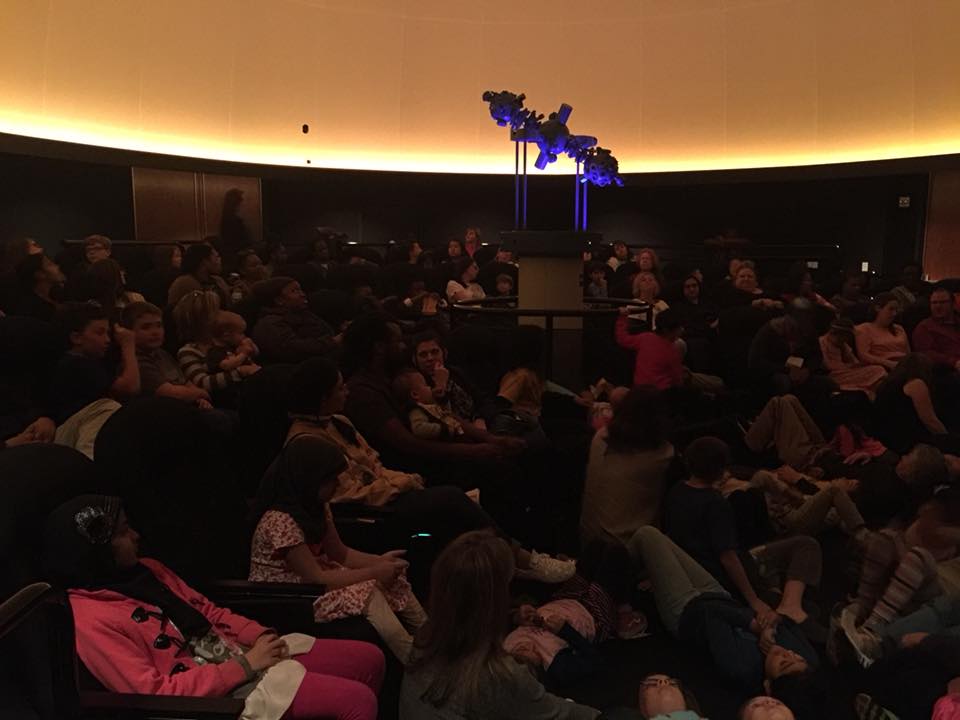
Planetarium
What is it?
The planetarium, one of the key features of Emory's Mathematics and Science Center, is a 56-seat classroom space designed for teaching undergraduate astronomy and hosting events and seasonal programs that explore and celebrate the cosmos. When the house lights go down, it's a place to sit back in comfortable chairs, relax, gaze up and imagine that the 35-foot domed ceiling above really is filled with countless stars as it appears to be. In fact, each one is being projected by a relatively small but hard-working piece of equipment stationed below.
How does it work?
 All the heavenly bodies that seem to glow from outer space are simulated by the Zeiss Skymaster ZKP3, a German-made star projector. Operated by a small control panel, a portable PC keyboard and accompanying software, it incorporates 39 projecting lenses of different sizes. Working individually or in groups, they beam thousands of light points onto the planetarium's curved ceiling screen. A member of the physics department - usually planetarium director Dr. Erin Bonning, or director emeritus, Dr. Richard Williamon - orchestrates the display of celestial objects to explain specific concepts or to develop a broader narrative theme.
All the heavenly bodies that seem to glow from outer space are simulated by the Zeiss Skymaster ZKP3, a German-made star projector. Operated by a small control panel, a portable PC keyboard and accompanying software, it incorporates 39 projecting lenses of different sizes. Working individually or in groups, they beam thousands of light points onto the planetarium's curved ceiling screen. A member of the physics department - usually planetarium director Dr. Erin Bonning, or director emeritus, Dr. Richard Williamon - orchestrates the display of celestial objects to explain specific concepts or to develop a broader narrative theme.
What can the Skymaster do?
- The Skymaster ZKP3 shows everything you would see with the naked eye on a clear night under perfect viewing conditions.
- It projects over 7,000 individual stars besides star clusters, nebulae, galaxies, the Milky Way, constellations, the planets Mercury, Venus, Mars, Jupiter, and Saturn, and the Earth's Sun and Moon.
- It excels at representing the apparent movement of celestial objects and can accelerate their motion to help make a point.
- The Skymaster is usually programmed to simulate the sky over Atlanta; however, it can easily represent the night sky from any place in the northern or southern hemispheres.
- It can also function as a time machine by recreating the night sky for any moment in history-past or future.
- And it can even project line drawings that outline the major constellations an especially helpful feature for those of us with less imagination than the ancient astronomers who named them thousands of years ago.
Our Planetarium's claim to fame
There are over 500 Zeiss planetariums worldwide. The Emory Skymaster, installed on July 24, 2002, is the only one built on its own rising platform; when not in use, it descends below floor level to be hidden out of sight. Then the planetarium becomes a normal classroom, perfect for lectures and colloquia.
The Skymaster's compact size is especially well-suited to university planetariums; it is the smallest of several types of star projectors manufactured by the German-based Carl Zeiss Company—a leading producer of optical equipment that has been in business since 1846. The firm created the world's first planetarium in Munich in 1923.
Planetarium resources for Emory University
The planetarium's primary mission is to enhance the teaching of undergraduate astronomy in the department of physics. It also serves as a resource for other departments and areas of the University interested in cross-disciplinary applications. We invite faculty and staff members with ideas for collaborative projects to contact the planetarium director, Dr. Erin Bonning.
Events and programs for the Emory Community
Find out more about Special Events in the planetarium and the Emory Astronomy Club.
Several special events and seasonal programs are planned throughout the year for the enjoyment of the Emory community and local groups. Topics are most often astronomical, but the planetarium's cozy ambience and intimate scale make it a setting for live music and the performing arts on campus.
